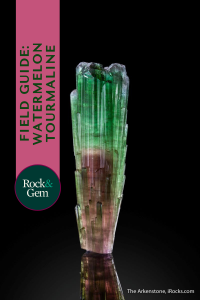
Watermelon tourmaline may be the most popular variety of tourmaline found. The name tourmaline means “stone of many colors” in Sinhalese. Watermelon tourmaline exhibits its characteristic bi-color appearance resembling the fruit favorite with a pink or red center surrounded by a green outer layer. Its Mohs scale of hardness of 7 to 7.5 makes it a popular and durable jewelry favorite.

Formation & Color
Watermelon tourmaline is a variety of concentrically color-zoned tourmaline and is distinct from longitudinal bi-color or polychrome zonation also commonly observed in tourmalines. The name was coined by George Robeley Howe (1860-1950) of Norway, Maine, when describing specimens from the Havey Quarry in Poland, Maine.
Watermelon tourmaline is generally the mineral species elbaite, fluor-elbaite or liddicoatite which are all species of the tourmaline group. They form primarily in granite pegmatites, which are rich in elements like lithium, manganese and boron. As these elements cool and solidify, watermelon tourmaline begins to crystallize from the residual magma.
The color zoning seen in watermelon tourmaline occurs because of a changing chemical environment during formation. Initially, the crystal grows with a high h concentration of manganese, which gives the inner core its pink-to-red color. As the fluid’s chemical composition shifts, elements like iron or chromium m become more prevalent and form the outer green layer. Its colors are like visual class notes of this gem’s formation.

Where It Is Found
Watermelon tourmaline’s most notable deposits are found in Minas Gerais, Brazil. It is also found in Africa (particularly Namibia and Nigeria), Afghanistan, Sri Lanka, Australia and the United States (California and Maine). The most famous mineral specimens come from the Tourmaline King Mine and Himalaya Mine in San Diego County, California, the latter was one of the largest producers of gem and specimen-grade tourmaline in North America throughout the 20th century. Recently, exceptional watermelon tourmaline has been mined in the Goma region of the Democratic Republic of the Congo.
History
It wasn’t until the 19th century that watermelon tourmaline began to be recognized scientifically as part of the tourmaline family. By the late 1800s, mineralogists classified tourmaline into two different varieties: elbaite and schorl. These days, the tourmaline group comprises 44 different mineral species!
Popular Tourmaline
Watermelon tourmaline has become popular in high-end and artisanal jewelry markets since each stone is distinct. It is also popular with metaphysical believers. It is considered to be a powerful heart chakra stone with the green layer bringing in the nurturing and healing energies of nature and the pink layer bringing love, compassion and emotional healing.
This story about watermelon tourmaline previously appeared in Rock & Gem magazine. Click here to subscribe. Story by Dr. Stuart Mills and Pam Freeman.













